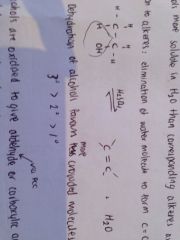![]()
![]()
![]()
Use LEFT and RIGHT arrow keys to navigate between flashcards;
Use UP and DOWN arrow keys to flip the card;
H to show hint;
A reads text to speech;
15 Cards in this Set
- Front
- Back
|
Optical isomers may be
|
Chiral or achiral
|
|
|
Enantiomers
|
Mirror images are NON superimposable, posses a chiral centre
|
|
|
Diasterisomers
|
(Non-enantiomers) ie not mirror images
|
|
|
Number of sterioisomers
|
2^n where n = number of chiral centres
|
|
|
R/S naming
|
1. Locate stereocentre
2. Lowest group points away 3. Read from highest to lowest priority (not including group behind the plane) |
|
|
R
|
R= clockwise
|
|
|
S
|
S= anticlockwise
|
|
|
Mesocompound
|
Contains a plane of symmetry and 2 or more chiral centres
Decreases number of stereocentre sod a compound Achiral - therefore not optically active |
|
|
Racemic mixture
|
Equimolar amounts of both enantiomers (optically inactive)
|
|
|
Haloalkanes
|
- polar R-X bond readily attacked by nucleophiles
Undergoes nucleophillic substitution and B-elimination |
|
|
Sn1 mechanism
|
- 2 steps
- C-X bond breaks to form a carbocation intermediate - favours more stable carbocation (3*>2*>1*>methyl) |
|
|
Sn2 mechanism
|
- 1 step
- bond breaking and bond formation is simultaneous - Nu- attack from backside - less crowded molecules favoured (methyl>1*>2*>3*) |
|
|
B-elimination (Haloalkanes)
|
Formation of alkenes from Haloalkanes
- occurs in the presence of a strong base - major product = most highly substituted molecule |
|
|
Alcohol dehydration
|

Conc H2SO4
- favours more crowded molecules (3*>2*>1*) |
|
|
Oxidation of alcohols
|
1* alcohol - aldehyde (via PCC) or carboxylic acid
2* alcohol - to ketones (PCC or H2CrO4) 3* alcohols cannot be oxidised |

